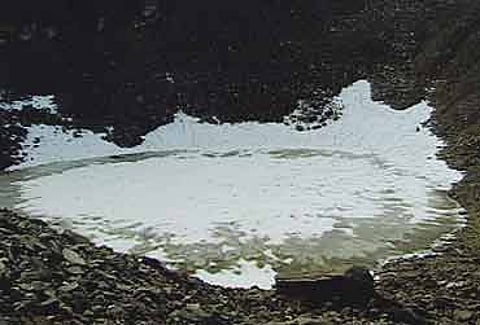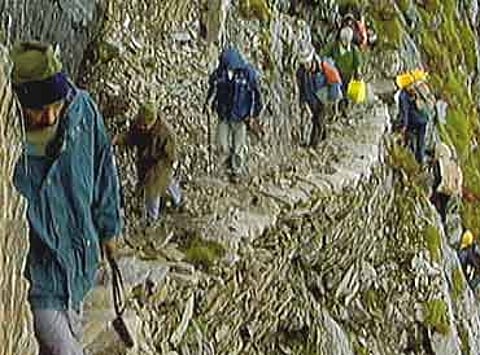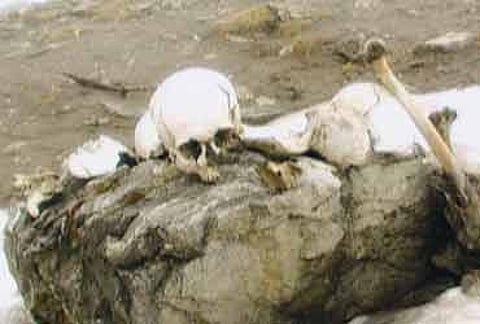That idea spawned Skeleton Lake, a documentary that offers the best explanation yet on the mystery of Roopkund, to be aired on the National Geographic Channel on November 9. It's part of a series called Forensic Investigation Report, which examines mysteries from all over the world—these range from the strange alchemy behind the liquefying blood of San Gennaro, one of Italy's most famous religious events, to uncovering the story of a 700-year-old murder in Peru.
Though there were several theories on how the bones got there, none seemed to stand up to rigorous analysis. National Geographic and Miditech figured that one way to get a better set of answers to the Roopkund riddle would be to attack from several sides, through many disciplines.
One of the first people they spoke to was professor William Sax, a cultural anthropologist at Germany's Heidelberg University. Sax enjoys the sort of acclaim in his field that, say, a Tendulkar might in cricket. He has been studying the hill people and their collective memories and myths for decades. He was familiar with a traditional song sung by women of the area which describes the rage of the goddess Nanda Devi at interlopers who sacrilegiously brought carnal behaviour into her sanctuary. She rained death upon them, with hailstones "hard as iron". Sax wondered how this belief might connect with the team's findings.
Bones Of A Riddle
A TV docu reaches startling findings on the Himalayan mystery of Roopkund


He was part of a team that visited Roopkund in 2003. It included Prof Rakesh Bhatt, a forensic scientist at Garhwal University; Pramod Joglekar, a paleopathologist at Pune's Deccan College; and M.P.S. Bisht, from Garhwal University's geology department. As Miditech's Chandramouli Basu, who directed the film and visited Roopkund several times during the project, says, "We expected this multidisciplinary approach would help."
As indeed it would. Despite inclement weather, the team was able to spend enough time at the frozen lake to find plenty of bones. That wasn't all. They also found wooden artifacts, and iron spearhead, leather slippers, and stunningly, frozen bodies. The bones were to yield a remarkable tale of their own, but the tissue samples the scientists took from the bodies also provided DNA that suggested a startling conclusion as to where these people came from.
It's a compelling tale of how experts from vastly removed fields were able to piece together the elements of a tragedy. At Oxford's research laboratory for archaeology and history of art, Tom Higham would use cutting-edge radiocarbon dating methods to date the Roopkund samples to the 9th century, at least 300 years older than any previous analysis. He was also able to establish that everybody in Roopkund died at the same time.
Then D.K. Bhattacharya, a prehistoric archaeologist at Delhi University's anthropology department, found the remains were of two distinct types. One was markedly taller, while the other, smaller kind shared a distinct depression in their skulls—such as what one might find on porters carrying weights with head straps.
S.R. Walimbe, like Joglekar a paleopathologist at Pune's Deccan College, would then assemble the final, conclusive pieces of evidence. Among the first type of skull he found unusual bone patterns that suggested a genetic abnormality. It was a strong hint that these were blood relatives. The bones were also clearly those of women and children, not just men. This, and the absence of old injuries, suggested that these were not the remains of soldiers.

The expedition team believed that the bones didn't show the massive damage that an avalanche would have caused. Walimbe concurred, and then determined something remarkable. The skull bones showed damage from hard, cricket ball-sized objects. Fatal damage.
Roopkund's notoriously fickle weather is no mystery, so the likely answer wasn't far to seek. A violent hailstorm caught this mixed party of outsiders and local porters by surprise. And that was how Sax found an eerie echo of an old mountain myth of an angry goddess who rained death.
Finally, Lalji Singh's DNA tests at Hyderabad's Centre for Cellular and Molecular Biology would also suggest an identity of this mystery "family" that died so cataclysmically. His findings support Walimbe's idea that they were relatives, since the DNA matched. He also discovered that some samples showed genetic mutations specific only to Maharashtra's Kokanastha, or Chitpavan, Brahmins.
Might the lineage that gave us Milind Soman, Dadasaheb Phalke, Kiran Nagarkar, V.D. Paluskar, Ajit Agarkar, Lokmanya Tilak have suffered catastrophically on a Himalayan slope some 40 generations ago? It's an intriguing thought.
Tags